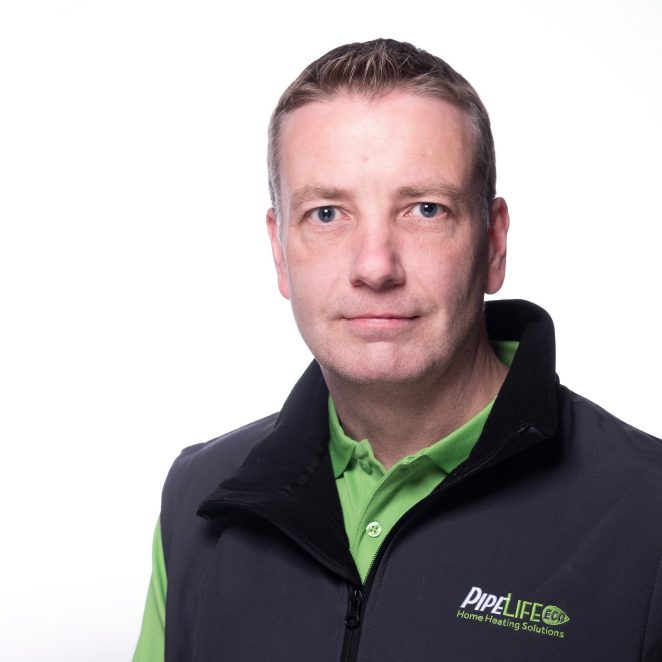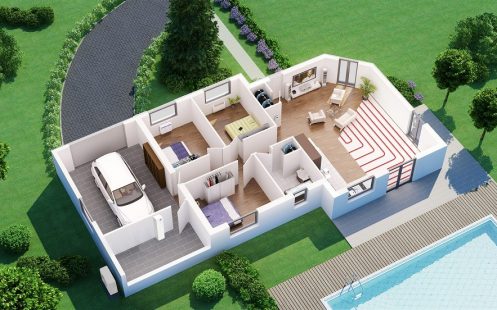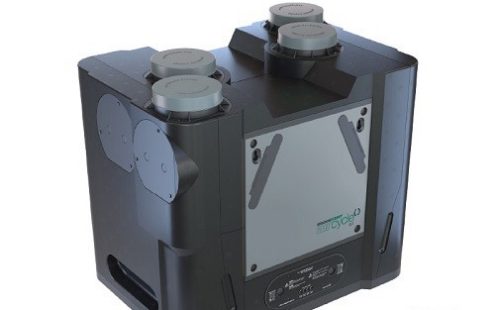Heat Recovery Ventilation Systems aircycle Range
Mechanical Ventilation with Heat Recovery (MVHR) works by recovering heat from extract air that would normally be expelled to the atmosphere and transfers this heat to fresh air being drawn into the property via a heat exchanger. The Heat Recovery Ventilation (HRV) system then distributes this throughout your property via a network of ducting.
The ducting is brought to each habitable room and each wet room within your property. Each wet room is fitted with an extract valve and each habitable room with a supply valve.
The Heat Recovery Ventilation system continually extracts from the wet rooms, boosting if necessary, removing the pollutant air quickly and effectively at its source. This air then passes up through the network of ducting and travels through a heat exchanger where its heat passes to the fresh filtered air which is being brought into the property at the same time.
Aircycle - Heat Recovery Ventilation (HRV) (MVHR)
Brookvent aircycle Heat Recovery Ventilation ( HRV ) systems are designed to provide superior air comfort levels and at the same time conserve energy by minimising heat wastage. This heat recycling is achieved by recovering heat from extract air that would normally be expelled to the atmosphere and transferring this heat to fresh air being drawn into the property, which the system then distributes throughout.
1.jpg)
How Does Heat Recovery Ventilation Work (HRV)?
Mechanical Ventilation with Heat Recovery (MVHR) works by recovering heat from extract air that would normally be expelled to the atmosphere and transfers this heat to fresh air being drawn into the property via a heat exchanger. The Heat Recovery Ventilation (HRV) system then distributes this throughout your property via a network of ducting.
The ducting is brought to each habitable room and each wet room within your property. Each wet room is fitted with an extract valve and each habitable room with a supply valve.
The HRV system continually extracts from the wet rooms, boosting if necessary, removing the pollutant air quickly and effectively at its source. This air then passes up through the network of ducting and travels through a heat exchanger where its heat passes to the fresh filtered air which is being brought into the property at the same time.
The HRV system runs on trickle speed continuously and is boosted when an increased rate of ventilation is needed, for example bathing or cooking.
When the weather is warmer a summer by-pass function helps to ensure comfort levels in the home. When this function is activated the property continues to be ventilated with fresh filtered air but the heat recovery process is switched off intermittently and therefore ‘by-passed’.
What are the benefits of Heat Recovery Ventilation (HRV)?
- Some of the main benefits of a Heat Recovery Ventilation (HRV) system are:
- Whole house ventilation – continuous balanced ventilation with improved indoor air quality, providing a healthy living environment and preventing condensation by keeping moisture levels low
- Energy saving – recovering the heat from your extract air instead of simply sending it to atmosphere can lead to significant energy savings by reducing the cost of your heating bill
- No additional kit – with the growing trend towards property air tightness, HRV systems cancel out the need for background ventilators
- Gain SAP points – Our aircycle HRV systems are SAP approved and succeed in reducing CO2 Dwelling Emission Rate (DER). Specifiers, Low Carbon Consultants and Architects can gain SAP points for your property by using our product’s specific performance information instead of standard default information provided in the SAP register
How is Heat Recovery Ventilation installed (HRV)?
Design: it is absolutely vital to have your Heat Recovery Ventilation (HRV) system installed properly. This begins with a good design. Pipelife is very experienced in system design and provides professional guidance on ducting routes across a wide variety of residential properties.
Installation: HRV systems are generally installed in two stages – 1st and 2nd fix. At 1st fix stage the majority of the ducting is installed, as per the system design, and any wiring requirements are provided for, including the tracking of remote sensors such as humidistats. At 2nd fix stage the system is installed, all ducting and wiring is connected, ceiling valves are fixed to the ducting point in each room, and the condensation drain from the system is installed. Finally the system is commissioned as per the appropriate Building Regulations.
Performance: the size and location of the HRV unit is extremely important. The unit must be fit for purpose, taking into consideration the size of the property and associated airflow rates.
Commissioning: We issue commissioning certificates detailing the measured installed airflow performance of each system against design requirements. Finally, each unit’s operational and maintenance requirements are clearly defined and demonstrated to ensure competent user operation and optimum system performance.
What does the term Specific Fan Power (SFP) refer to?
Mechanical systems require electrical power to operate, including power to the fans, any compressor(s) and transformer(s) and control and safety devices. The term ‘specific fan power’ is used to compare the electrical energy use for different ventilation systems as installed (i.e. allowing for system resistance).
Specific Fan Power (SFP) is defined by the Energy Savings Trust as: ‘The power consumption, in Watts, of the fan (plus any other electrical system components) divided by the air flow through the system, in Watts per litre per second (W/l/s)’.
Specific Fan Power Calculation: Heat Recovery Ventilation (HRV)
For a small house with a Kitchen + 1 Wet Room the minimum extraction airflow rate is 21 l/s (Part F: Eng & Wales 2010). If the unit consumes 15 watts to achieve this rate of air flow then: SFP: 15 / 21 = 0.71 W/l/s
The Energy Savings Trust Best Practice recommendation for SFP is 1 W/l/s or lower. The aircycle 3.1 Heat Recovery Ventilation unit currently achieves a SFP down to 0.37 W/l/s, which makes it the market leader in terms of efficiency.
What does the term Heat Recovery Efficiency refer to?
Most Heat Recovery Ventilation (HRV) systems including the aircycle range, are air-to-air types. These recover heat from the exhaust air stream and use it to pre-condition the incoming air from outside. The effectiveness of these units is given by its heat recovery efficiency i.e. the proportion of waste heat that is usefully recovered by the process (this figure is typically expressed as a percentage).
A heat recovery unit will reduce the amount of energy needed to heat up the incoming air to room temperature. This benefit must always be balanced against the electrical power requirements needed to drive the process. HRV systems are most efficient in more airtight homes, where almost all ventilation takes place via the heat exchange core. The concept is simple, the less heat that is lost through the leaks in the building envelope then the more heat there is to recover.
The Energy Savings Trust Best Practice recommendation for heat recovery efficiency is 85% or higher. The aircycle 3.1 Heat Recovery Ventilation unit currently achieves up to 93% heat recovery efficiency which makes it one of the market leaders in the industry.
What are the typical running costs?
All aircycle Heat Recovery Ventilation (HRV) systems are SAP approved and use EC fan technology which helps to ensure a low Specific Fan Power (SFP) which means our systems run as efficiently as possible.
Heat Recovery Ventilation systems will generally save significantly more money through heat recovery versus what it costs to run the system, therefore covering its own cost of running and also contributing towards savings on the space heating bill of the property, in some cases up to 20%.
Our experts are here to help you!


Additional Information
What Is A Heat Recovery System And How Does It Work?
A heat recovery system is a ventilation system that recovers stale air from wet rooms in the house (kitchen, bathroom, etc.), filters it, and transfers it as clean air to the rest of the property. This promotes balanced air ventilation within the house to improve air quality, whilst also recovering heat from extract air that would otherwise have been wasted. This means that a heat recovery system is beneficial for your health, pocket, and the planet.
So that’s what a heat recovery system is, but what you might be wondering is how on earth does it actually work?
Well, a heat recovery unit is effectively a multi-faceted ventilation system. Mechanical heat recovery ventilation (MHRV system), works by recovering heat from extract air that would otherwise be expelled to the atmosphere and transfers this heat to fresh air being drawn into the property via a heat exchanger.
If we lost you at MHRV, don’t worry, it’s really not as complicated as it sounds. If we break the process down into steps it looks something like this:
Stale air is extracted from wet rooms whilst fresh air is being drawn into habitable rooms via a heat exchanger, creating a constant airflow
A heat recovery unit (HRV system) located at the top of the property works to recover the heat from the stale air and transfer it to the fresh air
The heat recovery system expels the pollutant air quickly and efficiently, whilst supplying the recovered, clean air to the rest of the property
The clean air is supplied throughout the property via a network known as ‘ducting’. Each wet room is fitted with an extract valve and each habitable room is fitted with a supply valve
This means that stale air is continually being extracted whilst fresh air is continually being supplied to pass through the heat recovery system
The result? A reduced necessity for space heating coupled with a healthier and more comfortable environment for the homeowner.
Heat Recovery Systems At PipeLife
Here at PipeLife, our Aircycle heat recovery ventilation (HRV) systems are designed to provide superior air comfort levels whilst at the same time conserving energy by minimising heat waste. The Aircycle 1.3 and Aircycle 3.1 digital ranges offer innovative heat recovery systems that are highly efficient, quiet, and versatile.
Now that you know how a heat recovery system works, you may be wondering how you can get one installed on your own property. To make a general inquiry or request further information about any of our services, please don’t hesitate to get in touch with our friendly team today.

.jpg)
